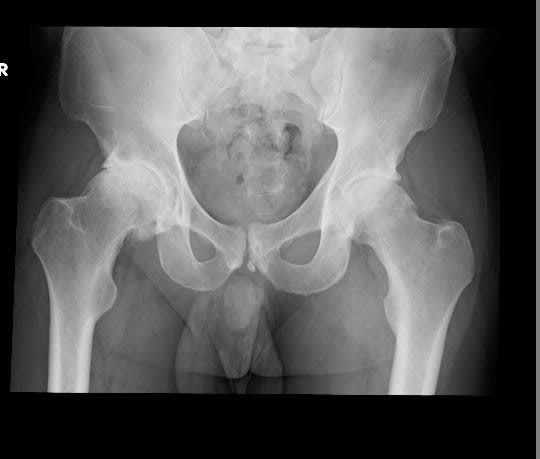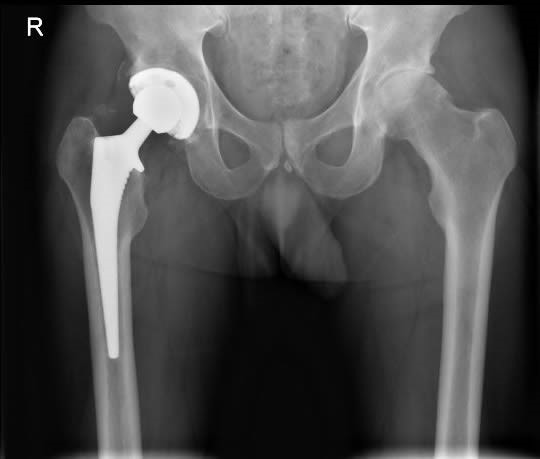
Hip arthritis can be extremely debilitating. Patients often feel pain around the upper thigh but mostly in the groin (yes, that’s where a hip joint is!) Other classical symptoms are difficulty in putting on shoes and socks, getting in and out of a car, limping and pain during intimacy.
As the arthritis progresses patients report worsening difficulty sleeping during the night due to pain. This symptom is generally a game changer for most orthopaedic surgeons as it means that some form of surgery should be considered to improve the patient’s quality of life.
Over the years our expectations have not surprisingly changed. We expect to live longer, and we expect to be more active in later years.
A middle aged patient typically prefers an active lifestyle and remain involved in sporting activities such as golf and tennis, and hobbies like cycling, hiking and hill walking. I would be delighted to provide an expert opinion, recommendations and realistic outcome of treatment options for these patients.
Non-operative treatment of hip pain
Hip and knee arthritis are not life threatening conditions. In the majority of cases there is no need for urgent surgery. It is always better for you to try various steps other surgery to manage your symptoms. These steps will also help you immensely during your recovery if you need an operation in future.
Help yourself:
- Weight reduction: Easier said than done I know but even moderate weight reduction will improve your hip and knee pain immensely. Not only that, it will reduce your risk of complications after the surgery should you need it in the future. It is a good idea to seek expert help for weight management: it will be worth it!
- Light exercise & Aqua-therapy: Please try to keep yourself mobile with light walks whenever possible. This will prevent muscle weakness and maintain stamina. You should undertake non-impact exercises such as cycling and pilates, cross-trainer and yoga if possible. Gentle exercises in the pool to tone and strengthen your muscles will be of great help even if you can’t swim.
- Balanced diet: Adequate nutrition is essential for healing. Your diet should involve healthy portions of various components including fruits, vegetables, meat and oily fish. You can also get expert advice from a good dietician.
- Stop Smoking: This is a no-brainer!
Help from your GP:
- Your GP should be your first point of contact if you need further help. They can advise you regarding appropriate painkillers and can also refer you to a very successful ‘Lifestyle Management’ program if you need it.
Help from me:
Based on my assessment of your condition, I may offer a joint injection of steroid and local anaesthetics if you are not ready or do not want an operation. Many patients do find significant pain relief for some time but length of pain relief is not guaranteed. I also do not tend to operate within 3 months of joint injection
Hip Replacement
If your symptoms haven’t resolved with pain killers and physiotherapy, the time may have come for a hip replacement.
The results of hip replacement surgery are very predictable and recovery is reliable in most cases. It is extremely successful in improving your quality of life – in reducing pain and stiffness and in increasing your mobility. I perform about 200 successful hip replacement procedures per year.


The long term success of hip replacement depends on ‘Getting It Right First Time’ and this requires meticulous pre-operative planning and perfect execution of this plan during surgery.
It involves removing the worn hip joint and replacing it with metal implants in the socket (Pelvis) and thigh (Femur) bones. I will show you the actual implants which I recommend once I have assessed you. You might be surprised to note that they are not connected to each other! It does need a reasonable amount of skill from your surgeon to achieve a good balance between movement and stability of hip joint. The operation takes approximately 60-90 minutes to complete and your expected length of stay in hospital is between 2-3 days – but many of my patients are ready to go home the next day or sometimes on the same day, i.e., ‘Day-Case’ hip replacement!
I recommend that you do ask your surgeons a few key questions about the operation. A responsible surgeon will always welcome this.
My Approach
There are numerous other approaches utilised by surgeons based on their training and experience. Your surgeon should be able to explain the advantages and disadvantages of these if you wish to know. Thanks to my extensive training both nationally and internationally utilising all hip approaches, I decided to adopt a minimal invasive (Less than 10 cm) posterior approach to perform this challenging operation. The main advantages of this approach are less blood loss and quicker recovery to get your normal lifestyle sooner. This is followed by an ‘Enhanced Recovery’ rehab strategy after the operation to get best results.
Implants I Use
These are a crucial part of the operation. Your surgeon must use appropriate implants with an excellent long term track record. I only use implants from reputable company like Stryker® Limited and Smith & Nephew® Limited which have proven excellent results on the National Joint Registry (NJR) of England, Wales and Isle of Man. Very rarely, a complex reconstruction case will require an innovative or custom made implants and I will fully explain to you the rationale for using these implants.
For acetabular (socket) reconstruction, I use titanium implants. The femur (thigh) component vary between uncemented Titanium or high grade stainless steel implant which is fixed using bone cement. The bearing material of connection between these is made of ceramic on very high grade polyethylene. The advantage is a very low wear rate, making new joint last for many years with minimal complications.
My Results
I am delighted to inform you that my post-operative complications and revision rates for any technical error are well below national rates and I will be more than happy to share the detailed data with you, should you wish to scrutinise it. This can be verified from NJR data.
What to Expect During a Hip Replacement
Pre-operative Assessment
Once you have decided to proceed with surgery, the first step is to assess your fitness for the surgery. Our very experienced pre-operative assessment nurses under the supervision of our consultant anaesthetist will perform a thorough physical assessment of the patient. This includes various blood tests, an ECG, chest x-rays if indicated and screening swabs for MRSA. They will also perform a risk assessment of your home circumstances to make sure that you will be safe to return home following surgery.
They will also advise you which of your normal medication to stop (if any) and when to restart them after surgery.
Rarely the nurse or doctor what is pre-assessing you may decide that it is not a good idea to perform your operation on a private basis because you may need input from various other medical teams such as the cardiac or renal teams, or you might benefit from High Dependency Unit (HDU) back-up. Remember, your safety is our prime concern: if this happens, then I will carry over your care on an NHS basis and make any necessary arrangements to have you transferred accordingly.
Day of Surgery
On the date of surgery you will generally arrive a the hospital 60-90 minutes before the operation.
You will be greeted by our pleasant staff on arrival who will get you settled in one of our suites with en-suite facilities. Our member of staff will verify your details, investigations and help you dress in a gown ready for the operation theatre. One of our junior doctors will assess you again to make sure that nothing has changed since your last pre-operative assessment and take a final blood test.
The consultant anaesthetist responsible for your operation will advise you regarding which type of anaesthesia you should have. This can be either an epidural/spinal anaesthetic (i.e. you will be awake but numb below the waist) or general anaesthesia. You will take a final decision on what anaesthesia to have together but I generally advise you to follow the expert’s advice. They know what they are doing!
I will visit you prior to your surgery to complete the consent process, mark the side & site of the operation and answer any outstanding questions you might have.
Once the operation has been successfully completed, you will return to your suite after spending a brief period in the operating recovery room and start your rehabilitation.
Post-Operative Care and Rehabilitation
A perfectly executed operation needs a state of the art post-operative rehab and an attention to detail approach to make it successful.
The biggest game-changer in how we manage your care after the operation is the introduction of our ‘Enhanced Recovery After Surgery’ protocol which essentially includes excellent post-operative pain management, better control of sedation, nausea and vomiting; and intensive physiotherapy to get you going sooner after the operation. It has a huge role in making your recovery quicker and improve satisfaction. I work with an excellent team of consultant anaesthetists, ward staff, physiotherapists & occupational therapists to achieve this. It is one of my main research interests and I take a particular effort to make this protocol personalised according to each patient’s needs, expectations and lifestyle. I am a firm believer of this approach and have successfully implemented ‘Day-Case’ and ‘Fast-track’ (Overnight stay) pathways for suitable patients helping them recover quicker after these life changing operations.
You will also have a calf compression device during your hospital stay as well as a blood thinning injection (Clexane) for a few weeks after your operation to minimise the potential risk of blood clots in your legs or lungs.
Once your pain is under control and you are safe on your cutches you will be discharged home within a couple of days to continue your recovery under the supervision of our experienced physiotherapy team. There will be some precautions to observe for four to six weeks after hip replacement to make sure it heals fully.
In case of knee replacement, success depends largely on adequate pain control and intensive physiotherapy to regain a good range of movement ahead. I can not over-emphasize the importance of strict adherence to expert input from myself and our physiotherapy team.
Thanks to these measures, most of my patients start to walk unaided by four to six weeks and continue their recovery in a rapid and predictable manner.
